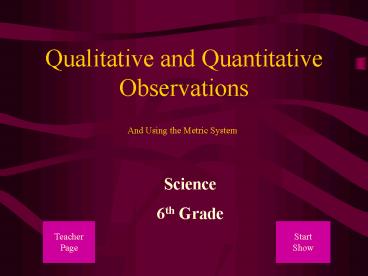Qualitative and Quantitative Observations - PowerPoint PPT Presentation
1 / 14
Title:
Qualitative and Quantitative Observations
Description:
Qualitative and Quantitative Observations. Science. 6th Grade. And ... Deca (dk) base times 10. BASE (meter, liter, or gram) Deci (d) base divided by 10 ... – PowerPoint PPT presentation
Number of Views:1859
Avg rating:3.0/5.0
Title: Qualitative and Quantitative Observations
1
Qualitative and Quantitative Observations
And Using the Metric System
Science 6th Grade
Teacher Page
Start Show
2
Qualitative Observations
- Describe an objects qualities.
- Use the five senses
- Sight
- Hearing
- Touch
- Smell
- Taste
- Are based on facts.
- Describe what the object is like.
3
You Try It!
- Pretend you are in this picture. Describe it
using qualitative observations.
4
You Try It!
Did you remember to describe
- What you would see?
- What you would hear?
- What it would feel like?
- How it would taste?
- How it would smell ?
5
Quantitative Observations
- Describe quantities.
- Use numbers as measurements or to count.
- Scientists prefer quantitative observations.
6
The Metric System
- Scientists use the metric system when measuring.
The metric system is based on the number 10, so
converting in the metric system is easy just
move the decimal point!
7
Basic Units in the Metric System
- Meter (m) measure distance
- Liter (l) measures volume
- Gram (g) measures mass (weight)
8
Prefixes in the Metric System
Kilo (k) - base times 1000 Hecto (h) base
times 100 Deca (dk) base times 10 BASE (meter,
liter, or gram)
King
Henry
Died
By
Deci (d) base divided by 10 Centi (c) base
divided by 100 Milli (m) base divided by 1000
Drinking
Chocolate
Milk
9
To Convert In the Metric System
- Put an X on the amount you know.
_____ ______ _____ ___X__ _____
______ _____ K H D B D
C M
36.54 m ______ cm
10
To Convert In the Metric System
- Put an X on the amount you know.
- Put a ? on the amount you are trying to find.
_____ ______ _____ ___X__ _____
__?___ _____ K H D B D
C M
36.54 m ______ cm
11
To Convert In the Metric System
- Put an X on the amount you know.
- Put a ? on the amount you are trying to find.
- Count from the X to the ?.
2
_____ ______ _____ ___X__ _____
__?___ _____ K H D B D
C M
36.54 m ______ cm
12
To Convert In the Metric System
- Put an X on the amount you know.
- Put a ? on the amount you are trying to find.
- Count from the X to the ?.
- Move the decimal point the same number of places
in the same direction.
2
_____ ______ _____ ___X__ _____
__?___ _____ K H D B D
C M
36.54 m _3654._ cm
13
To Convert In the Metric System
- Put an X on the amount you know.
- Put a ? on the amount you are trying to find.
- Count from the X to the ?.
- Move the decimal point the same number of places
in the same direction. - Add zeroes if necessary to be able to move the
decimal point.
14
To Convert In the Metric System
- Put an X on the amount you know.
- Put a ? on the amount you are trying to find.
- Count from the X to the ?.
- Move the decimal point the same number of places
in the same direction. - Add zeroes if necessary to be able to move the
decimal point. - If the number doesnt have a decimal point, put
it at the end of the number.
15
Teacher Page
- Science
- 6th Grade
- Created by Paula Smith
- I.A.1,5/ SC 7
- This presentation is intended to summarize and
practice what has been taught in class.
Start Show
End Show































